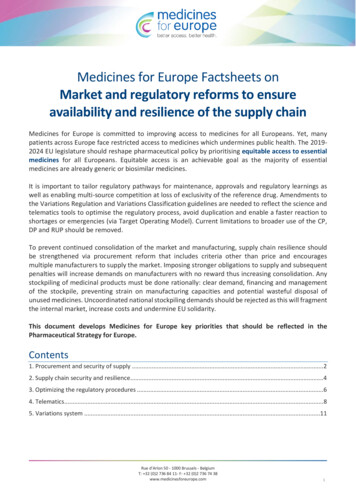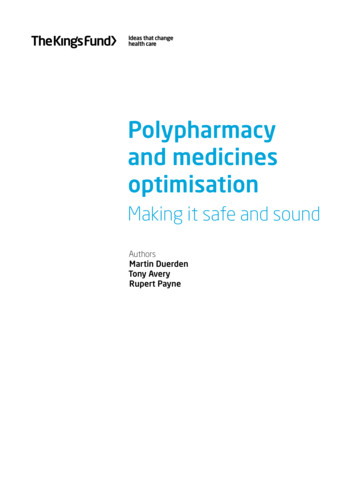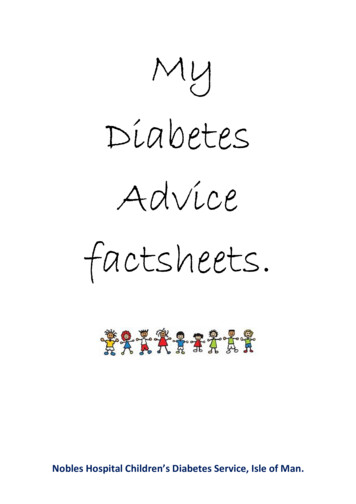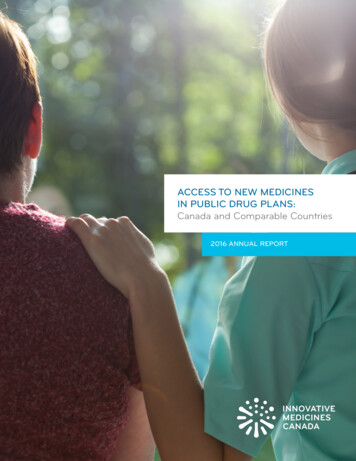
Transcription
Medicines for Europe Factsheets onMarket and regulatory reforms to ensureavailability and resilience of the supply chainMedicines for Europe is committed to improving access to medicines for all Europeans. Yet, manypatients across Europe face restricted access to medicines which undermines public health. The 20192024 EU legislature should reshape pharmaceutical policy by prioritising equitable access to essentialmedicines for all Europeans. Equitable access is an achievable goal as the majority of essentialmedicines are already generic or biosimilar medicines.It is important to tailor regulatory pathways for maintenance, approvals and regulatory learnings aswell as enabling multi-source competition at loss of exclusivity of the reference drug. Amendments tothe Variations Regulation and Variations Classification guidelines are needed to reflect the science andtelematics tools to optimise the regulatory process, avoid duplication and enable a faster reaction toshortages or emergencies (via Target Operating Model). Current limitations to broader use of the CP,DP and RUP should be removed.To prevent continued consolidation of the market and manufacturing, supply chain resilience shouldbe strengthened via procurement reform that includes criteria other than price and encouragesmultiple manufacturers to supply the market. Imposing stronger obligations to supply and subsequentpenalties will increase demands on manufacturers with no reward thus increasing consolidation. Anystockpiling of medicinal products must be done rationally: clear demand, financing and managementof the stockpile, preventing strain on manufacturing capacities and potential wasteful disposal ofunused medicines. Uncoordinated national stockpiling demands should be rejected as this will fragmentthe internal market, increase costs and undermine EU solidarity.This document develops Medicines for Europe key priorities that should be reflected in thePharmaceutical Strategy for Europe.Contents1. Procurement and security of supply .22. Supply chain security and resilience .43. Optimizing the regulatory procedures .64. Telematics .85. Variations system .11Rue d’Arlon 50 - 1000 Brussels - BelgiumT: 32 (0)2 736 84 11- F: 32 (0)2 736 74 38www.medicinesforeurope.com1
1. Procurement and security of supplyProblem statementSince the 2009 financial crisis, European Member States have introduced policies to reduce medicines prices tobalance healthcare budgets. These cost-containment measures have typically taken the form of reference pricing(internal or external), mandatory price reductions, procurement practices, rebates, clawback or a similarcontribution system and payback measures. Across Europe, the current procurement practices have generateda number of undesired effects, namely reduced competition, price erosion, supply constraints (e.g. need to havestock in house to bid) and consequently medicine shortages. On top of this, most procurement processes do nottake into account the unique characteristics of pharmaceutical manufacturing operations (e.g. lead times,accurate volumes, etc.), do not promote an adequate number of participating suppliers in tenders and do notguarantee competition as soon as market exclusivity period ends. Developing optimal procurement practices isan opportunity to create healthy competition and guarantee patient access to medicines, by increasing thenumber of manufacturers in the market and thereby reducing the risk of medicine shortages.Policy recommendationsThe existing procurement process should be optimised to ensurethe security of supply by: Adjusting the number of procurement winners according tothe market, product and country characteristicso Multi-winner tenders are preferred to guaranteemultiple manufacturers in the market and preventsupply issues. Using selection criteria that consider other factors than priceand ensure fair competition by implementing MEAT criteria.o These criteria should not put any access barriers inplace for generic, biosimilar and value addedmedicines.o Procurement criteria should consider product-specificcharacteristics.o Procurement criteria that consider other factors thanthe lowest price should ensure fair competition, suchas: Environmental criteria Supply reliability and manufacturing resiliencecriteria Product characteristics criteriao The non-price tender criteria should award a bonus,where the weight attributed to these criteria reflectsthe policy objectives. Guaranteeing that the procurement processes reopen afterthe entry of the first multisource medicine to ensure acompetitive and predictable supply to patients. Using extended lead times that guarantee a predictable supplyof medicines to patients.patients quality value sustainability partnership2
Lead times should be adapted to the product characteristics as well as the requested volumes to besupplied, to guarantee a predictable supply.Preventing disproportionate penalties to encourage a sustainable supply of medicines to patients.o Penalties should be proportionate to the contract value to ensure competition in the procurementprocess.o Before the application of penalties, there should be some flexibility to find solutions for theinterruption in supply.Accurate estimates of volume and volume commitments to be provided should guarantee a continuoussupply.o Example good practiceItaly: Regional authorities are now obliged to re-open the supply agreements within 60 days after theentrance of the biosimilar medicine to the market.If there are more than 3 competitors on the market, it is mandatory to select 3 preferred products.Germany: By law, there need to be 6 months between the award of a tender and the first delivery, ensuringsufficient lead time.Relevant documentation Position paper on best procurement practicesOfficial letter Medicines for Europe and EFPIA on second wave pandemic preparedness: procurementprinciplesInfographic Hospital Tenderingpatients quality value sustainability partnership3
2. Supply chain security and resilienceBackgroundPharmaceutical manufacturing and supply chains are complex, increasingly globalised and sometimes notsufficiently diversified. In principle, the generic medicines use should encourage the diversity of production andsuppliers as it is a multisource competitive market. However, pharmaceutical policies in Europe only encouragecompetition at market formation. Once the competition is established, most countries apply cost-containmentpolicies to the generic sector which drives consolidation and globalisation to lower production costs.Multiple manufacturers can be involved in the various production steps for a single ingredient. Upwards of 350components are needed to be produced in house or procured to produce a final medicinal product. Because ofthe consolidation of supply chains especially related to API manufacturers, for a substantial amount of medicinalproducts the API is manufactured and supplied by a small number of API manufacturers. The MarketingAuthorisation Holders (MAHs) are transparent on their supply chains via the details included in the MarketingAuthorisation Dossier as submitted to the National Competent Authorities (NCAs) or EMA. However, theCovid-19 pandemic showed that public authorities are unable to access this information about the structure ofthe manufacturing and supply chains.The European market for prescription medicine is dominated by government (direct or indirect) purchasingbased on obtaining the lowest price for most off-patent medicines. This jeopardises the strong manufacturingfootprint in Europe, disincentivises investments in European manufacturing and supply chain resilience measuresand generates market or manufacturing chain consolidation. Meanwhile, new regulations (e.g. FMD, Brexit,nitrosamines review, Pharmaceuticals in Environment, GMP annexes) require a manufacturer to invest more inmanufacturing and supply chain regulatory compliance which reduces the possibility to invest in moremanufacturing diversity.By integrating security of supply into EU pharmaceutical policy, the EU could reverse the trend of consolidation.The EU public procurement directive and transparency directive could be amended to include security of supplyin procurement and reimbursement policies. Pharmaceutical regulation could be amended to encourage ratherthan discourage manufacturing investment in resilience and contingency measures. For example, dual sourcingcan bring additional resilience into the supply chains, but establishing and maintaining multiple active API sourcesinto a regulatory dossier has a significant cost factor from a compliance and regulatory point of view. While it isessential to provide full oversight and transparency of the supply chain and product flow to the competentauthorities, the current way of handling the maintenance of API related information discourages companies fromregistering more alternative API suppliers to mitigate shortages. The simplification of this process would bringhuge benefit and will reduce duplication in the system and waste of resources on both the industry andauthorities’ sides. To encourage manufacturing in Europe, EU structural funds could encourage investments innew technology to maintain a competitive and sustainable production footprint.The EU Structured Dialogue on manufacturing and resilient supply chains is an opportunity to alignmanufacturers, stakeholders and the EU on a coherent strategy to improve the security of supply of medicinesfor European patients.patients quality value sustainability partnership4
Policy recommendations Based on the structured dialogue, pursue policy reforms to increase manufacturing security andresilience.Reward manufacturers for investing in supply resilience like double sourcing or inventory strategyThe EU can rebalance the market toward investment by legally rewarding resilience and security ofsupply or other relevant most economically advantageous tender (MEAT) criteria into theimplementation of Public Procurement and the Transparency Directives.NCAs to assess vulnerabilities in consolidated supply chains based on data submitted by MAHs in theregulatory dossiers and provide feedback on the highly consolidated products with limited approvedsuppliers (mainly API). The NCAs or EMA should create interoperable IT systems to identify thosemedicinal products having a highly consolidated supply chain and communicate this information back tothe pharmaceutical industry.Procedural simplifications to lower expenditures are needed to encourage companies to registermultiple API suppliersThe EU should set an ambitious goal to restore Europe to its former position as the leading globalmanufacturing region for the finished product (medicine) and active pharmaceutical ingredients (API) forboth the EU and the global market. Financial support should be combined with market incentives (valueadded medicines, green or multi-winner procurement market options that consider long-term volumeand price certainty) to ensure that these investments are ultimately financed by markets.patients quality value sustainability partnership5
3. Optimizing the regulatory proceduresIntroduction:Each medicine, before reaching the patient, needs to be approved by competent authorities. The regulatoryframework of Marketing Authorisation (MA) is critical to achieve the twin objectives of timely patient access tomedicines and assuring the sustainable long term development of the industry to meet patient needs in thefuture. The current system of MA is built on two main pillars: the Centralised Procedure (CP) when theassessment is led/ coordinated by the EMA; the Decentralised Procedure (DCP) when the assessment is led bythe Reference Member State (RMS).Issues:From the perspective of 50 years of pharmaceutical legislation, enormous progress has been made to achievebetter quality, safety and efficacy of medicinal products. Significant effort has been made to build a strongEuropean regulatory structure and harmonised European standards. However, the current regulatory systemsand their implementation do not always support the objectives of timely access and operational efficiency. Theweakness of the current system has been recognised and the revision of the MA framework has been announcedin the Pharmaceutical Strategy:A study* on the authorisation and monitoring of medicines for human use will inform the evaluation of theregulatory framework to simplify and streamline procedures and reduce costs.Although the outcome of the study is pending (to be published in 2021), Medicines for Europe recommendssome improvements to the operational aspects of EU marketing authorisation procedures to facilitate timelyaccess to generic and biosimilar medicines. †Centralised MA procedureThe Centralised Procedure (CP) was not designed with generic and biosimilar medicines in mind, leading tosome cumbersome and constraining steps for those medicines (i.e. duplicate MAs due to use patents, namingpolicy, eligibility etc) This has limited the use of the CP by generic manufacturers compared to DCP applications.While the CP procedure is mandatory for biosimilar medicines and optional for generic medicines, theseconstraints have limited the appeal and therefore the optimal use of the CP for patient access.Recommendation for CP procedureWhat is needed to achieve optimal CP processes?To remove the limitations of the Reinterpret the eligibility criteria to broaden access toCentralised Procedure for generic andgeneric medicines.biosimilar medicines Address the inflexibilities that have limited generic medicineapplications fully utilising the Centralised Procedure. Address the issue of brand naming of duplicates agreed onuse patent grounds to allow patient access to medicines inthe cross-border healthcare setting and to avoid markethurdles at the expiry of patents.*Study on the experience acquired as a result of the procedures for authorisation and monitoring of medicinal products forhuman use – to be published in 2021.†For deeper diagnosis of the current MA system, its weak and strong points and several detailed proposals for improvement,please refer to Medicines for Europe Regulatory Efficiency Reportpatients quality value sustainability partnership6
Decentralised Procedure (DCP)The Decentralised Procedure is the main route for registering generic medicines in Europe. Over 85% of themedicines being registered in Europe through DCP every year are generic medicines. Therefore it is crucial tofocus efforts on further improving this route to make these important medicines more widely and quicklyavailable to patients and providing the value which sustains the EU healthcare systems.Several suggestions have been made to optimise the Decentralised procedure for the regulatory approval ofnew generic medicines ‡ . The objectives of the proposed solutions are to streamline procedures, eliminateunnecessary duplications of approvals and enable rapid reaction to patients’ needs in new countries. Theseimprovements would more closely reflect the operation of the generic medicines industry and more importantlygive the possibility to respond faster to patient and market needs.RecommendationsWhat is needed to achieve an optimised Decentralised procedure?To address weak points of the DCP (i.e. Refreshing the Decentralised Procedure by introducing “BackboneRepeat Use Procedures (RUP) in DCP”- inspired by the Centralised Procedure, where there would beextending MA to new countries and a single harmonised assessment involving a rapporteur and comeeting patient needs. timelines, rapporteur, endorsed by CMD(h).duplications and inefficiency etc)Another option: “Basket DCP” - Member State assessing a “fullpackage/basket” of elements for a given product; with theMarketing Authorisation Holder choosing a tailored option for MA ineach Member State.Other areas for simplifications: ‡Variations (addressed in the Pharma Strategy separately as an area for improvement and digitalisation)Assessment of the documentation for the active substance, used by multiple manufacturers of thefinished medicinal products (addressed in the Pharma Strategy separately as an area for improvement)Further optimisation of the pharmacovigilanceThe digitalisation of the MA processes - switching from a document-based processes towards thesubmission, management and evaluation of structured data via a two-way common EU Regulatorysubmission gateway. Regulator data submitted once, as structured data and in one format only andreused by the authorities for various purposesFor detailed proposals on simplification of the DCP, please refer to Medicines for Europe Regulatory Efficiency Reportpatients quality value sustainability partnership7
4. TelematicsProblem statement and backgroundThere is an increasing trend in the proactive use of digital technology for wellbeing and health management. TheCovid-19 pandemic has proven the importance of e-Solutions to save lives and provide EU citizens safe access tovirtual medical services and information.Digital initiatives and tools are anchored on the access of correct and relevant data, which includes data andinformation on medicines (“regulatory data”). To achieve complete and effective empowerment of patients andsuccessful implementation of the Digital Health Agenda, regulatory data (such as product identification andauthorised medicinal product data) and related medicines information must be a part of the Digital Healthtransformation. The simplification of regulatory management, interconnection and interoperability of data andsystems will complete the digital patient journey by proving them access to significant information related totheir treatments and medicines. It will also help regulators getting quality data more quickly and reacting fasterto fulfil patient needs.Today the EU medicines regulatory network is still based on a decentralised and fragmented regulatory setup.Fragmentation of data across national regulators and the complex architecture has resulted in silo databaseswhich limit the potential use of the data.The pandemic demonstrated Europe’s data weaknesses and gaps across all countries and at the EU level. Theabsence of useable data led to panic, hampered the ability of the EU to play its role in ensuring equitable accessto medicines and weakened solidarity between member states. Industry-government cooperation enabled theEU and member states to develop ad-hoc solutions to medicines access challenges but we can clearly do muchbetter in the future.An effective digital regulatory system is an important first step to improve public health crisis management inEurope. Without harmonised standards, interoperability of systems and a data-driven regulatory process, thesharing of data amongst EU countries becomes challenging, as well as implementing protocols that enablechange, when there are threats.The creation of an interoperable digital medicine regulatory network is not a major technical challenge as digitaltools exist and manufacturers are well-versed in shifting from paper to digital formats of data submission. Thereal challenge has been the lack of timely and consistent implementation of digitalisation and interoperabilityacross EU member states.Policy recommendationsTo make Europe fit for the digital age, we need a coherent digital regulatory infrastructure at national andEuropean levels based on the interoperability of medicines agencies system. This would enable the collectionand analysis of regulatory data on authorised medicines appropriately and in a timely manner while engagingminimal human resources to search for data (as opposed to the current almost manual approach used today)patients quality value sustainability partnership8
Objectives Accelerated exchange of regulatory data between medicine agencies in member states and industry inan automated way (structured data packets).Optimisation of regulatory processes to gain time and unify approach.Accelerate digital-telematics infrastructure to link regulatory and supply chain data for all medicines.Create the building block to implement and develop the electronic product information (ePI).BenefitsThe digitalisation of the Regulatory Network infrastructure offers numerous benefits- i.e. better visibility of all parties in the supply chain, easier detection of potential supply issues having anEU-wide impact on access to medicines, optimisation of resources by automation of regulatory operations, incentives to maintain older, essentialproducts on the market by simplifying their maintenance etc. One example of benefits that digitalisation of the European Regulatory network and interconnection ofMedicines agencies system is related to the timely patient access to medicines information. Today, achange in the leaflet paper will reach the patients only when the new paper leaflet is embedded in thepatients quality value sustainability partnership9
medical package. In the future, with the digitalisation of the regulatory systems, patients and healthcareprofessionals can be alerted of leaflets updates almost in real-time after the Regulatory approval.Policy recommendations Institutions and regulators should prioritise the creation of an interconnected digital medicinesregulatory system across the EU. This is technically straightforward to implement and will improveaccess to essential medicines and vastly improve the EU’s ability to avoid shortages.The European Commission can speed up the digitalization regulatory process by providing some EUfunding to member state medicines regulatory agencies to invest in an EU-wide digital regulatorysystem as minor budgetary constraints have been a major factor of delay.patients quality value sustainability partnership1 0
5. Variations systemIntroduction:Throughout its lifecycle, medicine will evolve and require a significant number of regulatory changes. Somechanges (so-called: Variations to the Marketing Authorisation) might be significant (e.g. new indication, majorchange in manufacturing) when a deep assessment of the change is needed by the authorities to ensure quality,safety and efficacy of medicinal products. Some changes may be minor, quite often of an administrative nature,with no impact on the quality, safety and efficacy of the product (e.g. change of address of manufacturer) orneed for a deep assessment by the authorities.Issue:The current regulatory framework for maintaining products on the market needs to evolve to better reflectscientific progress and operational efficiency in line with Better Regulation which aims to balance regulatoryobjectives with the need to reduce the administrative burden for companies and authorities § . Currently,disproportionate resources are allocated to the variations process in view of the overall benefit for patients andthe entire regulatory system. The way of handling the process of changes needs to be digitalised to reduceresources used on administrative changes and to concentrate resources on activities that bring value to patientsand public health. In addition, the variations system needs to be responsive to scientific & technological evolutionand patient needs, as was also experienced during the COVID19 crisis.Policy recommendations:The weakness of the current system has been recognised in the Pharma Strategy:“Review the variation framework for medicines, through changes in legislation and guidelines, to make thelifecycle management of medicines more efficient and adapted to digitalisation – 2021-2023”The effective use of IT systems can be a powerful enabling tool for regulatory efficiency in the processing ofvariations across the EU Network. Regulation 1234/2008 was adopted at the time of relatively low digitalisationof the regulatory operations. Over the last 10 years, the regulatory environment has evolved significantly withregards to available IT tools and ongoing telematics projects – it is time to move to digital solutions. Thesimplification will reduce duplication in the system and save resources for both industry and authorities.Recommendation for digitalisation of What is needed to achieve it?variationsTo digitalise the process of reporting Switching from document-based processes to the submission,changestotheauthoritiesby management and evaluation of structured data via a two-waycommon EU Regulatory submission gateway.pharmaceutical companiesContinuity and speeding up of on-going digital projects (socalled SPOR database at the EMA, Target Operating Model(TOM)Harmonised and fast implementation by all EU MSs at the sametimeFor deeper diagnosis of the current variations system, its weak and strong points and several detailed proposals forimprovement, please refer to Medicines-for-Europe Variations Report§patients quality value sustainability partnership1 1
To modernise the concept of reportingchanges by reporting minor, mainlyadministrative changes directly only to thedatabase (not to several MSs in parallel),with the Competent Authorities having fullaccess to the contentTo make a link between the digitalisation ofvariations and future way of managingchangestoProductInformation(i.e. indications, the safety profile inpatients’ leaflet) and keeping patients andhealth care professionals informed aboutchanges to medicinal products via e-leafletFinancial support by the EU funding to digitaliseinterconnectivity between the health authorities and the EURegulatory networkAmendment to the legislation as a part of the review processby explicitly allowing the reference to the databases.Modernise the transfer of “information that has changed” inthe MA dossier (supply chain, safety updates, administrativedata handling) via digital innovation. e.g. responsible dataowner updates the respective databases, which is accessible byeach NCA (i.e. leverage the robust ISO IDMP data model viaSPOR database).Continuity of investing in the digital infrastructure of the EMAand National Authorities and in databases (SPOR and TOM),serving as a building block for the future model of electronicPatient information (e-leaflet).Investing in Electronic product information (ePI) is an integralpart of the Regulatory efficiency concept. In particular,a strategic way of designing the ePI IT system would improvethe Variation system as well.Other (not IT related) recommendations for changes to the current Variations regulatory and legal framework:RecommendationsWhat is needed to achieve it?Make the variation system responsive to scientific & technological evolutionand patient needsAmendment to theRevise current risk-based approaches to variation categorisation in view of pharmaceutical legislation,knowledge learned last 10 years for well-known / well-characterised Variations Regulation1234/2008 and the Variationsproducts, incl. biologicsFacilitate the continual improvement of manufacturing processes and the Classification Guidelinesadoption of innovative manufacturing technologies, especially in thecontext of global supply chains (i.e. ICH Q12).An efficient way of handling supply chain information and its changes viadigital tools will allow faster reaction in case of a major issue with supplyand risk of shortages (e.g. fast process to report changes to the activesubstance; API suppliers, etc). Procedural simplifications will encouragecompanies to register multiple API suppliers to prevent shortages.Facts and figures: Disproportionate resources are allocated to the variations process in view of the overall benefit forpatients and the entire regulatory system:o Based on data gathered from 2010-2018, the number of variations per MA and per yearappears to have increased about 75% since 2010.patients quality value sustainability partnership1 2
oo Over 50% of the total number of variations submitted to the Competent Authorities are minorchanges (Type IA Variations and Notifications), engaging a lot of resources from both regulatorsand the industry, to process these minor, mainly administrative submissions without scientificassessment and without any real added value for patients. By reducing the average time spent on the type IA notification process in general, as well aslowering the volume by changing the way of reporting, approx. 65% of the current effort couldbe saved/resources could be used differently on activities more meaningful for public health.patients quality value sustainability partnership1 3
2. Supply chain security and resilience Background Pharmaceutical manufacturing and supply chai are complex, increasingly globalised and sometimes not ns sufficiently diversified. In principle, the generic medicines use should encourage the diversity of production and suppliers as it is a multisource competitive market.










